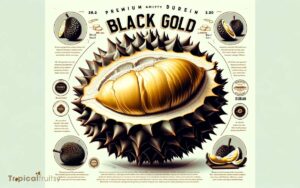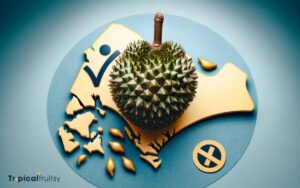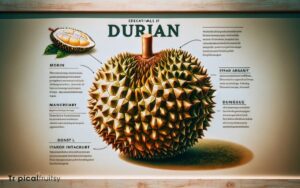Why Do People Eat Durian? Unraveling the Mystery!
People eat durian primarily for its unique taste and texture, as well as its nutritional benefits. The fruit is rich in vitamins, minerals, and healthy fats, making it a popular choice in Southeast Asia.
Durian’s creamy texture and complex flavor profile, often described as a blend of sweet and savory notes, appeal to those with adventurous palates.
It also has cultural significance in many Asian communities, where it is enjoyed during special occasions and festivals.
Durian’s consumption can be attributed to various factors:
Durian’s allure lies in its complex flavor and the cultural heritage it represents within Southeast Asian communities.

Key Takeaway
Nutritional Profile of Durian – The King of Fruits
| Nutrient | Content in Durian (per 100g) | Benefits |
|---|---|---|
| Calories | 147 | Energy provision |
| Carbohydrates | 27.09g | Energy, digestive health |
| Dietary Fiber | 3.8g | Aids in digestion, reduces cholesterol |
| Sugars | 6.75g | Immediate energy source |
| Fat | 5.33g | Provides essential fatty acids |
| Protein | 1.47g | Muscle repair and growth |
| Vitamin C | 19.7mg | Immune system support, antioxidant |
| Potassium | 436mg | Heart health, muscle and nerve function |
| Thiamin (B1) | 0.374mg | Energy metabolism, nerve function |
| Vitamin A | 44 IU | Vision, immune function, skin health |
| Calcium | 6mg | Bone health |
| Iron | 0.43mg | Oxygen transport, energy production |
Unique Nutritional Profile
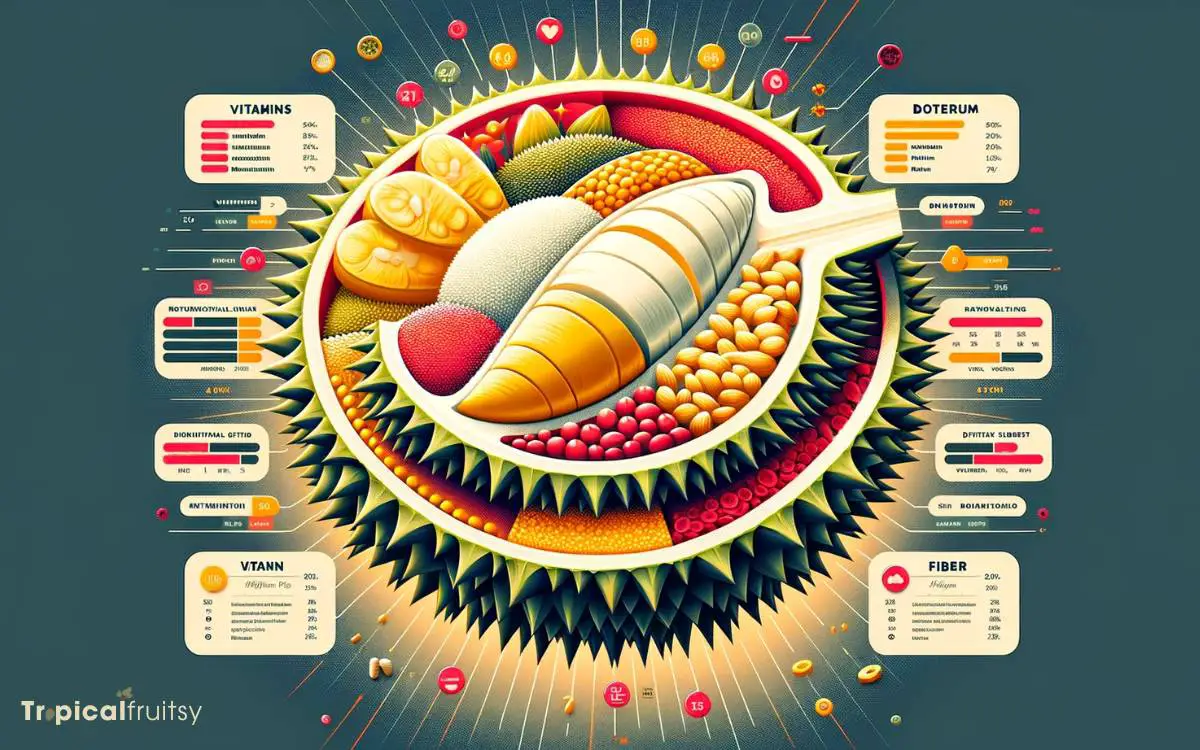
Durian fruit boasts a distinctive nutritional profile, rich in vitamins, minerals, and dietary fiber. This tropical fruit is an excellent source of vitamin C, a powerful antioxidant that plays a critical role in immune function and skin health.
Durians are also abundant in B vitamins, particularly vitamin B6 and thiamine, essential for energy metabolism and brain function.
The presence of minerals such as potassium and magnesium contributes to cardiovascular health by maintaining blood pressure and heart rhythm.
Moreover, the high dietary fiber content in durians aids in digestion and may help in maintaining a healthy weight.
Analyzing its composition reveals that durian is not merely a culinary delight but a powerhouse of essential nutrients, bridging the gap to its cultural and traditional significance.
Cultural and Traditional Significance
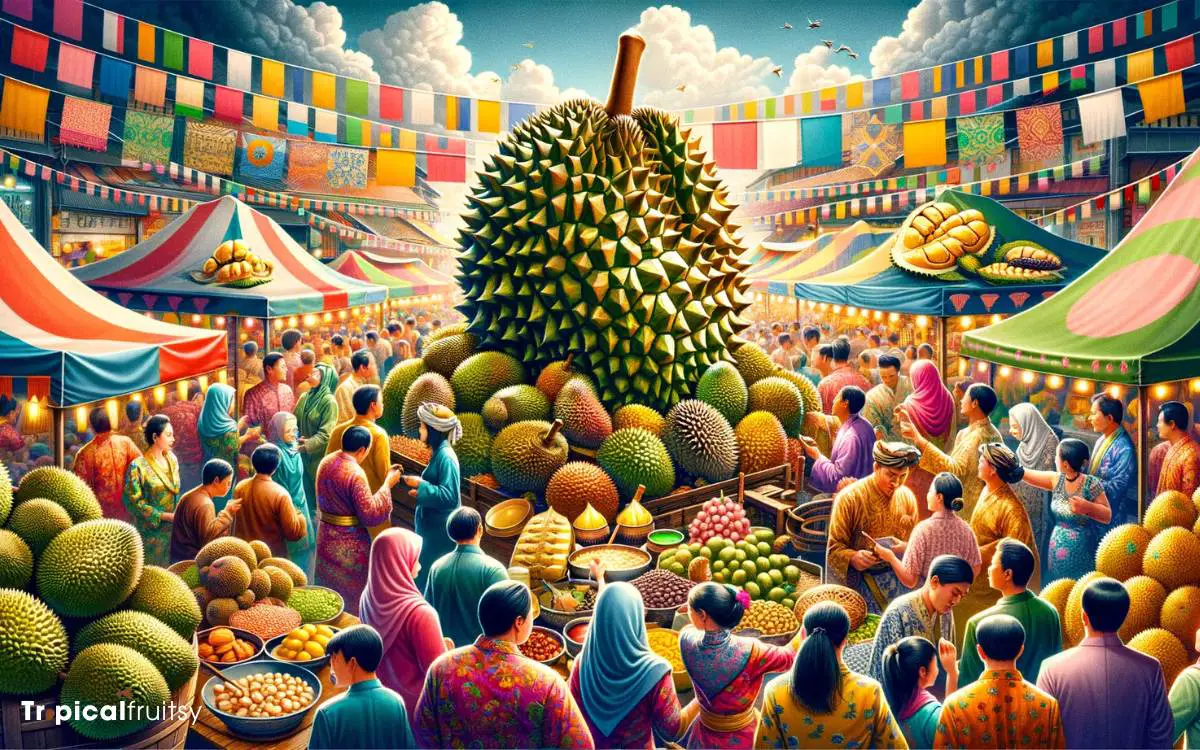
Historically, durian has frequently been celebrated as a symbol of social standing and cultural heritage in various Southeast Asian communities.
The fruit’s association with prestige is not merely due to its formidable appearance and strong aroma but also due to its deep-rooted presence in regional customs and rituals.
Durian’s cultural significance is multifaceted, illustrated by:
- Festive Celebrations: Durian is often a centerpiece at local festivals, signifying abundance and community.
- Gift-giving Practices: High-quality durian varieties are coveted gifts, reflecting respect and honor.
- Agricultural Heritage: Durian cultivation is a cherished traditional practice, with some trees being family heirlooms.
- Culinary Identity: Durian-based dishes are a source of national pride, showcasing the fruit’s versatility and cultural importance.
Analyzing these elements underscores durian’s role as a cultural mainstay, reinforcing its status as the ‘King of Fruits’ in Southeast Asia.
The Thrill of Exotic Flavors

The allure of durian among connoisseurs often stems from its status as a culinary challenge, providing a taste bud adventure that pushes the boundaries of familiar flavors.
Engaging with durian can also be seen as an act of cultural flavor exploration, where individuals seek to understand and appreciate the nuances of tastes that are integral to other societies.
The fruit’s exotic taste appeal lies in its unique combination of savory, sweet, and creamy elements, which intrigue the palate and invite debate among those who try it.
Taste Bud Adventure
Many individuals seek out durian as a way to embark on a taste bud adventure, chasing the thrill that exotic flavors provide.
The complex profile of durian is a challenge and delight for adventurous eaters. Its unique taste offers a surprising juxtaposition of creamy texture and pungent aroma.
Additionally, it has notes that range from sweet, custard-like flavors to hints of almond. The intensity of durian can overwhelm the unprepared palate, leaving a lingering aftertaste that continues the sensory experience.
In an analytical view, the pursuit of exotic tastes like durian reflects a deeper human inclination to explore the unfamiliar and expand one’s culinary horizons.
The experience of durian is not solely about the fruit but also about the personal journey of flavor discovery. This segues into the broader realm of cultural flavor exploration.
Cultural Flavor Exploration
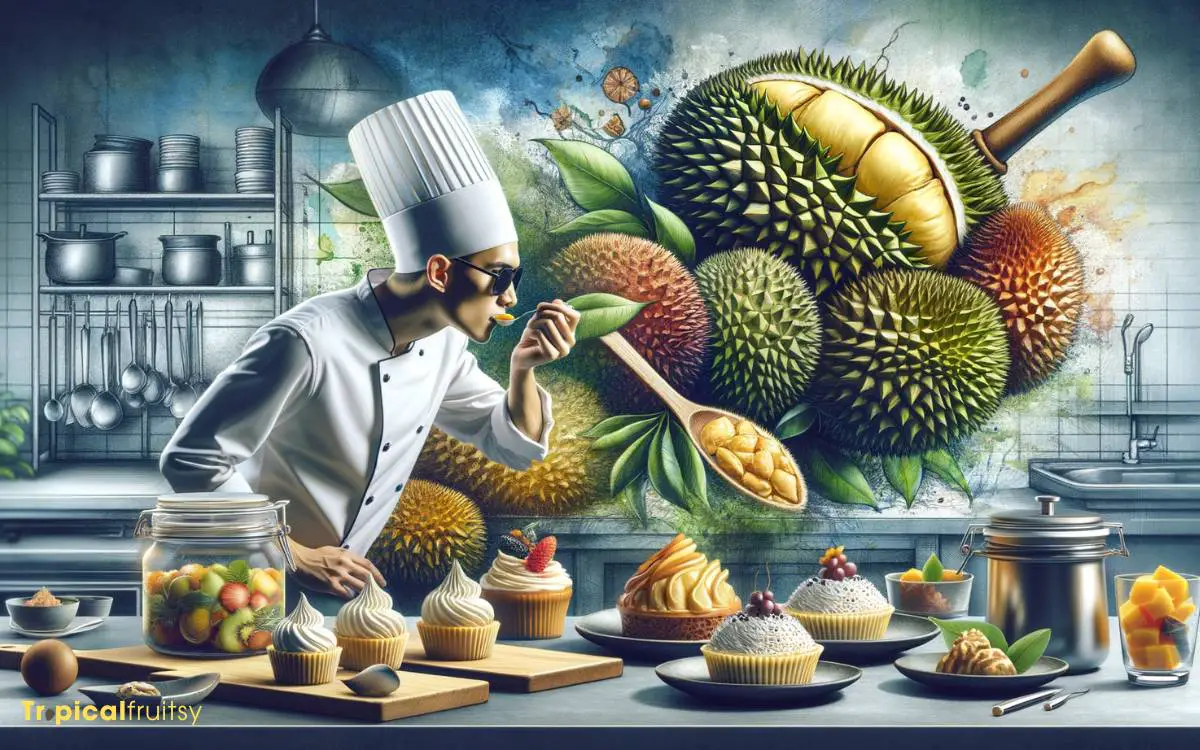
Frequently, the consumption of durian extends beyond personal taste adventures, reflecting a broader interest in the cultural significance and diversity of exotic flavors.
Enthusiasts often embrace the fruit as a symbol of regional identity, particularly in Southeast Asia where it is revered and deeply embedded in social and culinary traditions.
The durian’s notorious aroma and complex taste profile offer a window into the gastronomic heritage of its native lands, challenging palates and perceptions alike.
This exploration of cultural flavors is not merely an exercise in novelty-seeking but an informed pursuit of understanding and appreciating the culinary tapestry that defines different societies.
For the global gastronome, durian represents an opportunity to engage with the rich narratives that flavor can convey about place, people, and tradition.
Exotic Taste Appeal
One significant allure of durian consumption is the pursuit of exotic taste sensations that challenge conventional flavor boundaries.
Often referred to as the ‘king of fruits,’ durian is renowned for its distinctive, potent aroma and complex flavor profile that can be both intriguing and intimidating to the uninitiated palate.
The fruit’s taste has been described variously and vividly, capturing the essence of its exotic appeal:
- A rich, custard-like texture infused with hints of almond.
- A sweet and savory combination that defies easy categorization.
- An intense aroma that preludes a multifaceted taste experience.
- A lingering aftertaste that invites both contemplation and discussion.
Analyzing the durian’s exotic taste appeal reveals a dynamic interplay of sensory elements that both attracts and challenges culinary adventurers.
Texture and Culinary Versatility

The unique texture and culinary versatility of durian contribute significantly to its popularity among enthusiasts of exotic fruits. Its custard-like consistency juxtaposed with a spiky, hard exterior presents a fascinating contrast that intrigues the palate.
When utilized in cuisine, durian transcends mere fruit status, becoming a multifaceted ingredient in both savory and sweet dishes.
Its creamy texture allows it to blend seamlessly into confections, while its complex flavor profile can enhance the depth of savory dishes.
| Aspect | Emotional Response |
|---|---|
| Creamy Interior | Comfort |
| Aromatic Presence | Nostalgia |
| Flavor Complexity | Curiosity |
| Textural Contrast | Surprise |
| Culinary Adaptability | Anticipation |
Analyzing durian’s texture and versatility reveals its role not just as a food, but as an experience that engages and challenges sensory expectations.
Perceived Health and Medicinal Benefits
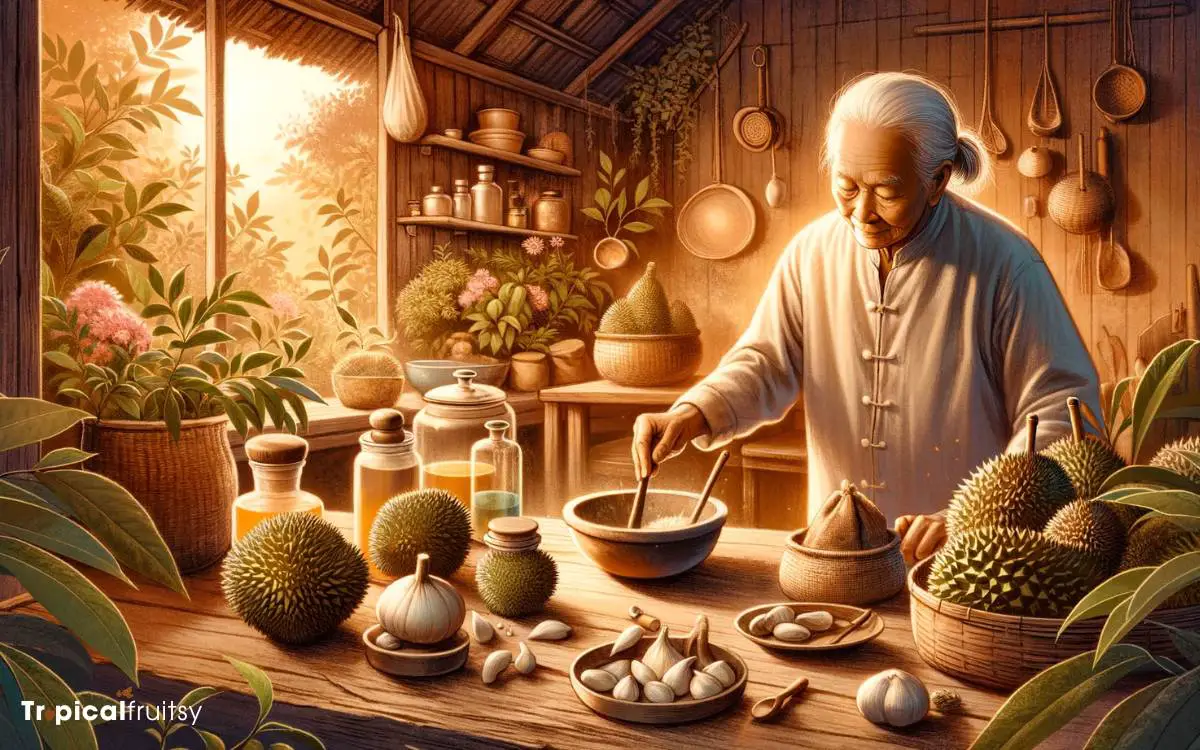
The consumption of durian is often justified beyond its sensory appeal, with advocates highlighting its rich nutritional profile that includes vitamins, minerals, and dietary fiber.
Additionally, various cultures have integrated durian into their pharmacopeia, utilizing it in traditional remedies for its supposed ability to alleviate a range of ailments.
Recent interest in functional foods has prompted scientific investigations into durian’s potential health benefits, reinforcing some of the longstanding claims while inviting skepticism for others.
Nutritional Content
Durian fruit is highly regarded for its rich nutritional profile, which includes a substantial amount of vitamins, minerals, and dietary fiber, conferring various health and medicinal benefits to consumers.
This ‘king of fruits’ is both celebrated and reviled for its pungent aroma and distinctive flavor, yet its nutritional content is irrefutably beneficial.
An analytical and descriptive examination of its composition reveals:
- High levels of vitamin C, crucial for immune system function and skin health.
- A significant amount of potassium, which is vital for maintaining healthy blood pressure and cardiovascular health.
- Rich in dietary fiber, promoting digestive health and regular bowel movements.
- Contains antioxidants, which may help protect the body against free radicals and reduce inflammation.
For those seeking to understand the appeal behind durian consumption, its nutritional content certainly adds considerable value to its consumption, beyond its unique taste and sensory experience.
Traditional Remedies

Beyond its substantial nutritional offerings, durian is also embraced in various cultures for its multitude of traditional medicinal applications, ranging from natural aphrodisiacs to anti-inflammatory remedies.
The fruit’s flesh, seeds, and even its husk are utilized in various ethnomedical practices, believed to address a broad spectrum of health concerns.
Analytically, the durian’s traditional uses are reflective of a deep cultural knowledge base, where empirical observations over generations have led to its integration into folk medicine.
| Traditional Use | Part of Durian Used | Perceived Benefit |
|---|---|---|
| Aphrodisiac | Flesh | Enhances libido |
| Fever reduction | Flesh & Husk | Lowers body temperature |
| Anti-inflammatory | Flesh & Seeds | Reduces inflammation |
| Digestive aid | Flesh | Aids in digestion |
| Wound healing | Husk | Promotes tissue recovery |
Modern Health Claims
While traditional remedies highlight durian’s historical significance, contemporary health claims focus on its potential benefits supported by modern science.
Durian is often marketed as a ‘superfruit’ due to its rich composition of nutrients, which has garnered attention in the realms of dietetics and holistic wellness.
Current research suggests various health advantages associated with durian consumption:
- Antioxidant Properties: Durian is lauded for its high antioxidant content, which may help in combating oxidative stress and reducing the risk of chronic diseases.
- Heart Health: Some studies indicate that durian might have a positive effect on heart health by reducing cholesterol levels and blood pressure.
- Digestive Benefits: The fruit’s fiber content promotes digestion and can aid in maintaining a healthy gut flora.
- Energy Boost: Due to its high carbohydrate and calorie content, durian is often considered a natural energy booster for those requiring increased caloric intake.
These claims are typically based on the presence of specific vitamins, minerals, and phytochemicals within the fruit, each contributing to its perceived medicinal value.
Social and Community Experiences

Partaking in the consumption of durian often serves as a bonding ritual within various communities, where the shared experience of eating the fruit can strengthen social ties and foster a sense of belonging.
This shared culinary venture, often perceived as a challenge due to the fruit’s pungent aroma and unique taste, becomes a collective endeavor, uniting individuals through a common, sensory experience.
Communities in Southeast Asia, where the durian is native, particularly exemplify this phenomenon.
The durian season becomes a time for social gatherings, with people coming together to savor the fruit’s creamy flesh, despite its divisive nature.
In this context, the act of eating durian transcends mere consumption—it’s a culturally embedded practice that reinforces community bonds and celebrates a shared heritage.
Why Do People Like Durian
The love for durian among its enthusiasts can be attributed to several unique attributes of the fruit, making it a delicacy with a devoted following.
Here are some reasons why people like durian:
Unique Flavor and Texture: Durian is celebrated for its rich, custard-like texture and a complex flavor profile that combines sweetness with a hint of bitterness.
This creamy texture and the depth of flavors are unmatched by any other fruit, making it a unique culinary experience.
Nutritional Benefits: Durian is rich in nutrients, including vitamins (particularly vitamin C and B vitamins), minerals (such as potassium, magnesium, and iron), and dietary fiber.
It also contains healthy fats and proteins, making it a substantial, energy-dense fruit. These nutritional attributes contribute to its appeal for health-conscious individuals.
Aromatic Intensity: While the strong aroma of durian is polarizing, those who love the fruit often find its smell to be intoxicating and appealing.
The aroma is an integral part of the durian experience, enhancing the fruit’s flavor and overall enjoyment.
Cultural and Social Aspects: In many Southeast Asian cultures, durian is more than just a fruit; it’s a cultural icon.
Sharing durian among friends and family is a social activity, and its consumption is often associated with special occasions and gatherings. This social aspect strengthens the bond between individuals and their fondness for the fruit.
Exclusivity and Seasonality: The seasonal nature of durian and its limited availability in certain regions add to its allure. For many, the anticipation of durian season is part of the excitement.
Moreover, premium varieties like Musang King are considered luxury items, making the experience of eating durian a special treat.
Variety: There are many varieties of durian, each with its own distinct taste, texture, and aroma. This variety means that enthusiasts can explore different types to find their favorite, adding an element of discovery and personal preference to the enjoyment of durian.
Sensory Experience: Eating durian is a full sensory experience that involves sight, smell, taste, and touch.
The combination of its distinctive appearance, pungent aroma, delicious taste, and creamy texture makes consuming durian a memorable and enjoyable experience for its fans.
Despite its divisive nature, durian’s unique characteristics have garnered it a passionate following, with many people cherishing it as the “King of Fruits.”
Conclusion
The consumption of durian is rooted in a complex interplay of nutrition, tradition, and sensory stimulation.
It offers a rich tapestry of cultural narratives akin to an orchestra’s symphony, where every element plays a pivotal role.
The fruit’s unique profile and versatile culinary applications, coupled with its social significance, underpin an experience that transcends mere taste, nurturing a communal bond and adventurous spirit in the pursuit of flavors that challenge the palate.




